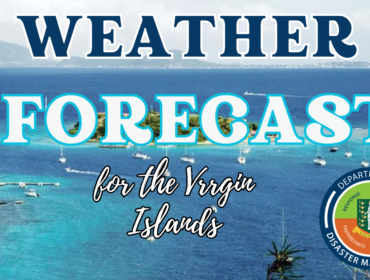Current Location: 15.4N/62.6W
Geographic Reference: 75 miles SW of
Guadeloupe Island
Movement: NNW at 12 mph
Max Sustained Winds: 35 mph to 40 mph
gusting 55 mph
Organizational Trend: Very slowly
becoming better organized
Chance of Development Within 48 Hours: 60 percent
Chance of Development Beyond 48 Hours: 80 percent
Changes from Previous Forecast
There are no significant changes.
Forecast
Satellite imagery and numerous surface observations across the
eastern Caribbean and Lesser Antilles indicate that the disturbance has a very
broad area of low pressure but no well-defined circulation center. A
reconnaissance plane is currently investigating the disturbance. Early reports
from the plane indicated that the low center is not well organized enough to be
classified as a depression or a tropical storm. A band of heavy squalls is
located 80 to 100 miles east of the broad low center. These squalls are
impacting the Lesser Antilles from Guadeloupe southward to near Tobago this
afternoon. There has been at least one report of a sustained 40 mph wind out of
Barbados earlier today, which indicates that the band of squalls does contain
some tropical storm-force, winds even though the disturbance lacks a
well-defined circulation.
The disturbance should track
north-northwestward to near the Virgin Islands in 24 hours then northward into
the open Atlantic on Sunday. It remains questionable whether the disturbance
will be upgraded to a tropical depression or a weak tropical storm before it
moves out of the eastern Caribbean tomorrow evening. Regardless of its
classification, the islands of the eastern Caribbean from near Trinidad
northward to St. Johns/St. Kitts will be experiencing occasional heavy squalls
with winds near the lower end of tropical storm force and gusts to 55 mph from
this afternoon through Saturday. The heaviest squalls will most likely pass to
the east of Puerto Rico and possibly east of the U.S. and British Virgin
Islands tomorrow afternoon and Sunday morning.
Once north of the Caribbean
on Sunday, a strong south-southwest to southwest flow aloft should accelerate
the system northward toward Newfoundland where it will arrive sometime on
Wednesday. However, by that time it will likely have lost all tropical
characteristics as it merges with a winter-type low over the region.
Expected Impacts on Land
Windward and Leeward Islands, including St. Lucia North to St. Johns/St.
Kitts: Thunderstorms will continue to
impact the southern and central Windward Islands through early Saturday
afternoon. Sustained winds of 30 mph to 40 mph with gusts to 55 mph can be
expected, along with widespread rainfall amounts of 3-6 inches and isolated
totals to 10-12 inches.
Puerto Rico/Virgin Islands: Heaviest squalls should remain east of Puerto Rico on Saturday.
However, some squalls may pass as far west as the U.S. and British Virgin
Islands during the day on Saturday as the disturbance passes overhead. Rainfall
amounts across the Virgin Islands will generally be in the 1-2 inch range,
though it’s possible that the area could see some heavier squalls with winds of
30 to 40 mph and gusts of 50 to 60 mph on Saturday afternoon and Saturday
evening.
Expected Impacts Offshore
Offshore St. Lucia: Sustained winds
of 25 to 35 mph with gusts to 60 mph in squalls are possible through tonight.
Offshore Trinidad: Sustained winds
of 20 mph to 30 mph with gusts to 45 mph in squalls are possible through this
evening.
Residents should pay close
attention to this system as it has the potential of being a Tropical Storm when
it approaches or pass close to the territory.
The Department of Disaster Management (DDM) is currently
monitoring the system and will provide updates accordingly. Please visit the
DDM’s website at www.bviddm.com and subscribe for future updates.
Disclaimer: The Department of Disaster Management (DDM) is not an
official Meteorological Office. The Information disseminated by the Department
is gathered from a number of professional sources used or contracted by the DDM
to provide such information. This information is to be used as a guide by
anyone who has interest in local weather conditions. By no means can the DDM or
the BVI Government be held accountable by anyone who uses this information
appropriately for legal evidence or in justification of any decision which may
result in the loss of finances, property or life.



